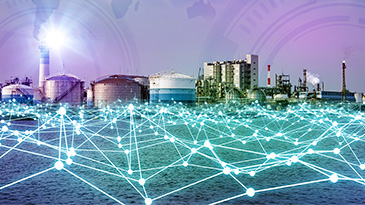The World Economic Forum says that a trillion dollars in value is available to the oil and gas industry through digital transformation. What does that mean, and how does an upstream company secure part of that?
Executives in the industry are pushing this area hard, and they want to know. More than that, they want to know, how do we get a return on a digital transformation investment?
Workers in the industry want to know too. My meetings across many upstream companies have convinced me that most staff don’t fully understand what this all means. But above all, people are worried about their future job security. To the individual worker, the question is, will my job be automated — and how soon?
I have good news (at least in my informed opinion)! Jobs in upstream aren’t going away. The nature of work, though, will change significantly. And the nature of organizations will also change. In fact, it is my view that there will be more job opportunities, because the cost structure of the energy industry will improve significantly, and the jobs will be interesting.
The worker, though, will need to be committed to his/her own flexibility and dedicate themselves to ongoing “retraining.” As many upstream companies diversify into new energy sources, the entire nature of these organizations will shift as they flatten and become more networked. Multiple energy sources will be built into optimized supply networks.
Defining Digital Transformation in Oil and Gas
The upstream executive has two burning challenges. The first is to understand and define for his/her organization, what exactly is digital transformation? The second is determining which areas to focus on to achieve those promised benefits (and doing it faster than the competition).
The industry has been battered and bruised by over 400,000 experienced workers leaving oil and gas since 2015, by economic and social pressures to become more sustainable by conserving use of water, energy and other resources, by the urgency to become carbon-neutral and by global market imperatives to reduce finding and production costs.
In this context, what is digital transformation for the upstream industry?
It is three main things. First it is the data and connectivity of assets on a massive scale. This concept is commonly referred to as the “internet of things” (IoT) or in some cases, the “industrial internet of things” (IIoT). Second, it is the application of AI (artificial intelligence, or machine learning) to this data to provide insight and to learn more and more over time from the asset and how it performs.
Third, it is the provision of this information on a wide scale across the organization, incorporating the “automation of knowledge,” to drive the decision-making process, based on data and analytics, at many levels and at many points within the organization. I call this digitally enabled distribution of decision-making the “democratization of the organization.”
Digital transformation promises to impact the upstream industry in many ways. Energy is an indispensable and immensely valuable commodity which faces dynamic uncertainty due to economic turbulence. Consequently, immense focus has been applied to the digital transformation areas that may have the biggest value impact soonest.
You can read the recent Newsweek Vantage report (authored by Dr. Carole Nakhle of Crystol Energy) to understand where technology is likely to be adopted first in oil and gas.
Seven Insights Into How Digitalization Will Impact the Industry
Insight No. 1: Reduce time to first oil
By speeding up sharing of data, improving speed in comparing alternatives and capturing knowledge in apps, the process of moving from discovery to production will evolve from a serial to a parallel activity. Eni reported at CERAWeek 2018 in Houston, TX that it has contracted the time to first gas in the offshore Egyptian gas field from five years to 17 months. This was largely through parallel, instead of sequential, asset development enabled by digital transformation.
Insight No. 2: Reduce drilling costs
Advanced analytics applied to prescriptive warnings of drill string problems can have a very high impact on drilling costs. A single trip on a complex directionally drilled well can easily cost the operator over $1 million dollars. Analytics are already preventing unnecessary trips.
Insight No. 3: Increase reliability
The highest impact area for the next five years is expected to be prescriptive maintenance, both for onshore oil and gas processing facilities and for subsea production. Every uptime hour or day gained is incremental revenue. Prescriptive understanding of how to take advance action to extend uptime has multiplicative value.
Insight No. 4: Get the most out of the asset
One of the biggest advances that digital transformation is already delivering is the ability to model, monitor and take action on key assets that are bottlenecking production. This is becoming faster, easier, cheaper and increasingly accessible to operators — and not only to specialist engineers. Units such as compressors, GOSPs, heat exchanger trains and the like can all benefit greatly from this digitalization trend. This turns oilfield data into actionable operating insights that maximize production and extend the life of equipment.
Insight No. 5: Improve productivity and results through remote operations
For remote fields, such as deep offshore and arctic locations, digital transformation means the ability to move many operations tasks out of the field into central operations centers. Almost all actions can be taken through advanced visualization interfaces, virtual views and advanced analytics, removing cost and risk from moving staff into these remote locations and by employing experts in one center to service multiple operating assets as the need arises. This is being pursued aggressively in areas as far apart as the North Sea and Borneo.
Insight No. 6: Reduce the capital cost of everything
In the hydrocarbon arena, the facilities needed to process the produced oil and gas are governed by known engineering processes. Why then, historically, has every facility been engineered “from scratch” (known in the trade quaintly as “open art”)? Instead, why not standardize and reuse designs based on the best-performing existing facilities?
Organizations ranging from ExxonMobil to Eni have pioneered the building-block reusable design concept. ExxonMobil reported in May 2017 (at OPTIMIZE 2017 in Houston, TX) that they have been able to cut the capital cost of new LNG processing facilities by 50 percent using this approach.
Insight No. 7: Improve sustainability
Minimizing energy use, water use and gas flaring makes sense both from a sustainability and economic point of view. Digital transformation provides the methods and raw analytical power to understand and optimize oil and gas production in a way that achieves strong sustainability results and superior economics. As executives know, this also improves access to capital markets.
So, in short, there are at least seven key business goals that can be dramatically impacted by embarking on a digital transformation journey. Mapping out your organization’s pathway will be a function of which of these key areas is most strategic and presents the biggest opportunity for you.
The ultimate impact and benefits will be larger and more far-reaching than any of us can forecast today!
For more thoughts, read my recent white paper Beyond Oil Digitalization: The Roadmap to Upstream Profitability.






Leave A Comment